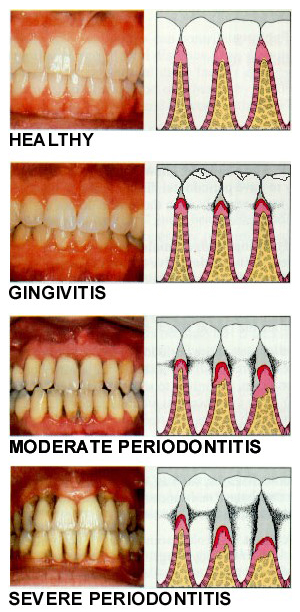How can one tell if one has gingivitis or periodontitis (gum disease)?
Three out of four people have periodontal disease and don't know it! Most people are not aware of it because the disease is usually painless in the early stages. Unlike tooth decay, which often causes discomfort, it is possible to have periodontal disease without noticeable symptoms. Having regular dental check-ups and periodontal comprehensive examinations are very important and will help detect if periodontal problems are present.
Periodontal disease begins when plaque, a sticky, colorless, film of bacteria, food debris, and saliva, is left on the teeth surfaces and gums. The bacteria produce toxins (acids) that inflame the gums and slowly destroy the bone (a support for your teeth). Brushing and flossing regularly and properly will prevent to develop gum disease.
Other than poor oral hygiene, there are several other factors that may increase the risk of developing periodontal disease:
* Smoking or chewing tobacco – Tobacco users are more likely than nonusers to form plaque and tartar on their teeth.
* Certain teeth or damaged restorative work – Bridges that no longer fit properly, crowded or misaligned teeth, defective fillings that may trap plaque and bacteria.
* Several medications – Steroids, cancer therapy drugs, blood pressure meds, oral contraceptives. Some medications have side effects as dry mouth and plaque easier to adhere to the teeth and gums.
* Pregnancy, oral contraceptives, and puberty – Can cause changes in hormone levels, causing gum tissue to become more sensitive to bacteria toxins.
* Systemic diseases – Diabetes, blood cell disorders, HIV / AIDS, etc.
* Genetics may play role – Some patients may be predisposed to a more severe type of periodontitis. Patients with a family history of tooth loss should pay more attention to their gums.
Signs and Symptoms of Periodontal Disease
* Red and puffy gums – Gums should never be red or swollen.
* Bleeding gums – Gums should never bleed, even when you brush vigorously or use dental floss.
* Persistent bad breath – Caused by bacteria in the mouth.
* New spacing between teeth – Caused by bone loss.
* Loose teeth – Also caused by bone loss.
* Pus around the teeth and gums – Sign that there is an infection present.
* Receding gums – Loss of gum around a tooth.
* Tenderness or Discomfort – Plaque, calculus, and bacteria inflames the gums and teeth.
Good oral hygiene, a balanced diet, and regular dental visits can help reduce your risk of developing periodontal disease. |
 |

